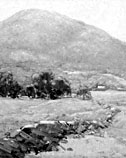|

Comment
on this story
What:
Louis E. Jones, Artist of the Smokies
Where:
The East Tennessee Historical Society Museum, 600 Market Street
When:
Through Sept. 30. No admission charge.
|
|

Adding "Artist of the Smokies" Louis E. Jones to our roster
by Heather Joyner
Until the 1982 World's Fair, whenever I mentioned where I was from, most non-East Tennesseans would tell me they were familiar only with Gatlinburg. I'd wince, knowing they must have seen the hillbilly dolls that emerge, pants down, from behind miniature outhouse doors—amidst heaps of corncob pipes and Confederate flags, no less. Despite its idyllic environs, Gatlinburg itself sent a potent message, sumthin' like "Don't mess with us lazy, crazy mountain people; just buy our goods and git." And this was before Pigeon Forge added insult to injury.
Back in the 1920s, however, Gatlinburg was barely a town. There were visitors, of course, but they were presumably more interested in rhododendron than in what Yankees call tchotchkes. They also bought art. And Pennsylvania-born Louis Edward Jones was there to create it and sell it to them (from his home, studio, and store known as the Cliff Dweller's Shop—the split-shingle-sided building that's been moved in lieu of demolition to a new location by artist Jim Gray). In fact, according to the East Tennessee Historical Society/ETHS Museum, currently presenting a small collection of Jones' mostly never-before-exhibited works, Jones was the first person to live in the mountains year round and make a living from his art. Yet we still know very little about him, although we might know even less if it weren't for Jim Gray.
Distinguished-looking with a beard and silver hair, Gray can be seen in a video that is part of the Jones exhibit (footage that, when edited, will appear on Channel 10's The Heartland Series sometime next week). In a taped conversation with Bill Landry, he expresses his delight at having come across Jones' art, saying, "He was a tremendous painter. I had no idea until I got into [the paintings] left in his studio. I had been asked to appraise them, and the more I went through the pieces, the more I fell in love with Louie Jones." Gray says Jones was born in 1878 and spent time at the Pennsylvania Academy of Fine Arts in addition to studying with teachers Birge Harrison and John Carlson of Woodstock, N.Y. He remarks, "This man was not an amateur. He was not a Sunday painter. This guy knew what he was doing and enjoyed every minute of it."
As for the condition of Jones' paintings and sketches when Gray found them, he says, "Some of them were stuck together, and they were all covered in dust. I was afraid to peel them apart...the appraisal had to be made based on a lot of restoration and cleaning." It remains unclear as to why they were left in such a state. Outlived more than a decade by his wife Emma (who died in 1972), Jones perhaps left no instructions as to what should be done with his art. Or maybe Emma couldn't face selling or even handling her late husband's work. We simply don't know. And the ETHS Museum's acknowledgment of Jones' legacy in the form of 32 canvases and four drawings—all without titles or dates—lacks much in the way of personal effects. There's a single black and white snapshot of the Joneses looking a tad shy in 1926, and a scruffy painting jacket from an Erie, Pa., haberdasher with a paintbrush in its pocket. That's about it.
Jones might have come to Gatlinburg after hearing about the area from his mentor Carlson, who was invited to Knoxville in 1913 by the artist Catherine Wiley. Or publicity surrounding the establishment of the Great Smoky Mountains National Park might have piqued his curiosity. Whatever the reason, Jones never left here, and we can therefore claim him as our own.
Like Charles Christopher Krutch before him, Jones celebrated our part of the world through his art. Not every brushstroke is brilliant, and although Jones has been called an American Impressionist, his images rarely harness the luminosity associated with that movement; furthermore, his two most impressionistic paintings in terms of light appear to be of a beach-like landscape far from our beloved Smokies. Numerous canvases beg to be larger in scale and would certainly benefit from better lighting. Although the exhibit features a range of works, it is uneven in terms of interest or quality. But when a piece stands out, as do several on display, it makes us eager to see more.
Jones' "#6" painting, of a red-roofed farmhouse and outbuildings gripping the side of an intensely green hill, has an unusual, steep perspective. It allows viewers a greater sense of place than do Jones' flatter, more frontal images of similar structures. The murky sensuousness of one of his streams makes snow in Jones' "#1" look like bluish felt, not the least bit wet or cold. On the other hand, you can almost smell the mossy dampness of a stone fence snaking into the distance in "#10." Snow in "#20" is equally unconvincing, but the painting succeeds at evoking winter's hush and darkness. An ode-of-sorts to the French Barbizon school, the "haystackscapes" that Jones created convey humility without sentimentality. However unoriginal their subject matter, they possess sensitive brushwork and a lovely subtlety of color.
In his taped interview, Gray says, "I think it's nice to take our heritage out of the box and look at it again...we take so much for granted, and we lose so much. It just goes away." Well, it won't if the ETHS can help it. As the Society breaks ground for construction of an impressive addition within the next four to six weeks, I look forward to its continued uncovering and presentation of "buried regional treasure." That will be a fine thing indeed.

August 9, 2001 * Vol. 11, No. 32
© 2001 Metro Pulse
|